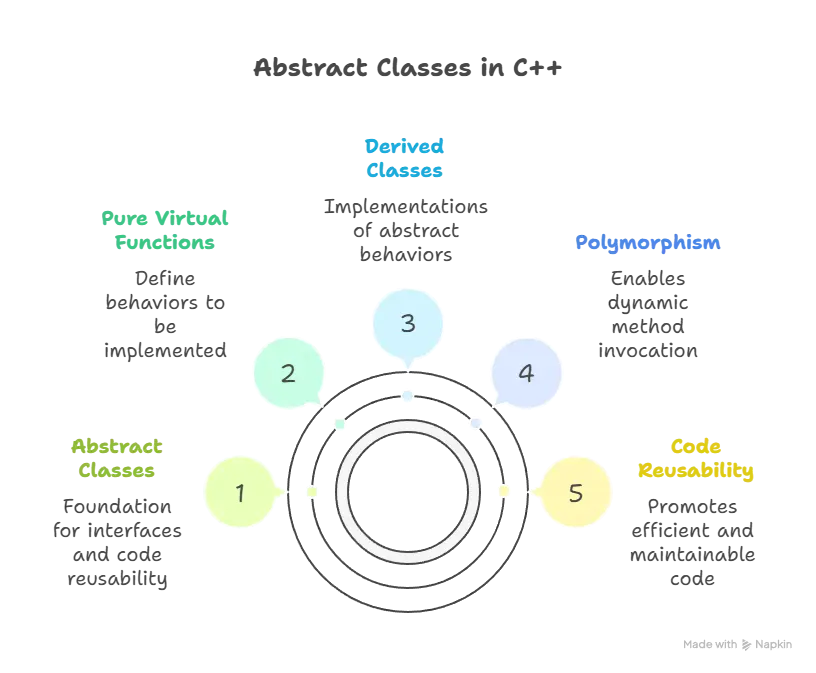Abstract classes
introductionThis chapter delves into the world of abstract classes in C++, a powerful concept for creating well-defined interfaces and promoting code reusability in object-oriented programming. We'll explore what abstract classes are, how they work, their benefits and use cases, and how they contribute to robust and maintainable code.
Imagine a blueprint for a building. It defines the overall structure and essential components but doesn’t specify the exact materials or decorations. Similarly, an abstract class in C++ serves as a blueprint for derived classes. It defines a set of behaviors (functions) that derived classes must implement but may not provide complete implementations itself.
Key Characteristic: Pure Virtual Functions
The defining characteristic of an abstract class is the presence of at least one pure virtual function. A pure virtual function is declared with the virtual keyword followed by = 0. It acts as a placeholder, forcing derived classes to provide their specific implementation for that function.
class Shape {
public:
virtual void draw() = 0; // Pure virtual function
};
This declares a pure virtual function draw() in the Shape class. Derived classes like Circle and Square must override it to define how they draw themselves.
Why Use Abstract Classes?
Abstract classes offer several advantages:
- Define Common Interfaces: They establish a contract or standard for derived classes, ensuring they implement the required functionalities.
- Promote Code Reusability: You can create reusable code in the base class that derived classes can inherit and extend.
- Enforce Polymorphism: Abstract classes enable polymorphism, where the same function call on a base class pointer can invoke different implementations based on the actual derived class object.
Creating and Using Abstract Classes
Declaring an Abstract Class
An abstract class with at least one pure virtual function is considered an abstract class itself. You cannot create objects directly from an abstract class because it doesn’t provide a complete implementation.
class Animal {
public:
virtual void makeSound() = 0; // Pure virtual function
};
This Animal class is abstract because of the pure virtual function makeSound().
Derived Classes and Overriding Virtual Functions
Derived classes inherit from the abstract class and must override all pure virtual functions to become concrete classes (from which you can create objects).
class Dog : public Animal {
public:
void makeSound() override {
std::cout << "Woof!" << std::endl;
}
};
class Cat : public Animal {
public:
void makeSound() override {
std::cout << "Meow!" << std::endl;
}
};
Here, Dog and Cat override the makeSound() function, providing their specific implementations.
Using Abstract Classes with Pointers and References
Even though you cannot create objects directly from an abstract class, you can declare pointers or references to them. This allows you to hold objects of different derived classes that inherit from the abstract class.
void makeAnimalSound(Animal* animalPtr) {
animalPtr->makeSound(); // Calls the overridden version based on the object's type
}
int main() {
Dog dog;
Cat cat;
makeAnimalSound(&dog); // Output: Woof!
makeAnimalSound(&cat); // Output: Meow!
}
In this example, the makeAnimalSound function takes an Animal pointer but can work with objects of derived classes (Dog and Cat) due to polymorphism.

Deep Dive into Abstract Classes
Abstract Base Classes and Interfaces
Abstract classes with pure virtual functions can be seen as interfaces. They define the functionalities that derived classes must implement, similar to how interfaces work in other programming languages. This promotes code clarity and maintainability.
Virtual Destructors and Abstract Classes
When dealing with inheritance and memory management, virtual destructors become crucial, especially with abstract classes. A virtual destructor (declared with virtual ~) in the abstract base class ensures proper object destruction in the derived class hierarchy.
RTTI (Run-Time Type Information) and Abstract Classes
RTTI (using the typeid operator) can be used to determine an object’s type at runtime. However, it’s generally recommended to rely on polymorphism through virtual functions whenever possible, as RTTI can introduce tight coupling and reduce code readability.
Advanced Concepts with Abstract Classes
CRTP (Curiously Recurring Template Pattern)
The Curiously Recurring Template Pattern (CRTP) is an advanced technique that leverages an abstract class template to access derived class members within the abstract class itself. It’s a powerful but less commonly used pattern, so we’ll provide a high-level overview:
template <typename Derived>
class Shape {
public:
void someFunction() {
static_cast<Derived*>(this)->derivedFunction(); // Access derived class function
}
};
class Circle : public Shape<Circle> {
public:
void derivedFunction() {
std::cout << "Circle specific function..." << std::endl;
}
};
int main() {
Circle circle;
circle.someFunction(); // Output: Circle specific function...
}
In this example, the Shape class template uses CRTP to access the derivedFunction() of the derived class (Circle) within the someFunction() method. This pattern can be useful for generic programming techniques with abstract classes.
Abstract Factories
The Abstract Factory pattern is a creational design pattern that uses an abstract class to define the interface for creating objects of different related classes (often derived from an abstract class). This promotes loose coupling and allows for flexibility in creating object families.
When to Use Abstract Classes
Here are some key scenarios where abstract classes are beneficial:
- Defining common behavior for a group of related classes.
- Enforcing a contract for derived classes to implement specific functionalities.
- Promoting polymorphism and enabling flexible object-oriented designs.
When to Avoid Abstract Classes
Consider alternatives like interfaces (if available in your C++ version) or pure functions for simple scenarios where you only need to define behavior without inheritance. Abstract classes can introduce some overhead with virtual tables, so use them judiciously.
Abstract classes are a cornerstone of object-oriented programming in C++. They provide a powerful mechanism for creating well-defined interfaces, promoting code reusability, and enabling polymorphism. By understanding their concepts, benefits, and limitations, you can leverage them effectively to design robust and maintainable C++ applications.Happy coding !❤️
